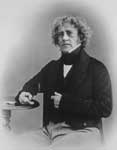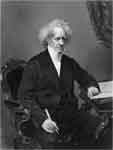
|
Sir John Frederick William Herschel, 1st Baronet KH, FRS (March 7, 1792 – May 11, 1871) [2] was an English mathematician, astronomer, chemist, and experimental photographer/inventor.[2] He was the son of astronomer Sir William Herschel and the father of 12 children.[2] Herschel originated the use of the Julian day system in astronomy. He named seven moons of Saturn and four moons of Uranus. He made many contributions to the science of photography, and investigated colour blindness and the chemical power of ultraviolet rays. Early life and work on astronomy Herschel was born in Slough, Berkshire, and studied at Eton College and St John's College, Cambridge. He graduated as Senior wrangler in 1813.[2] It was during his time as an undergraduate, that he became friends with Charles Babbage and George Peacock.[2] He took up astronomy in 1816, building a reflecting telescope with a mirror 18 inches (460 mm) in diameter and with a 20-foot (6.1 m) focal length. Between 1821 and 1823 he re-examined, with James South, the double stars catalogued by his father. For this work he was presented in 1826 with the Gold Medal of the Royal Astronomical Society (which he won again in 1836), and with the Lalande Medal of the French Institute in 1825, while in 1821 the Royal Society bestowed upon him the Copley Medal for his mathematical contributions to their Transactions. He was made a Knight of the Royal Guelphic Order in 1831.[2] Visit to South Africa Declining an offer from the Duke of Sussex that they travel to South Africa on a Navy ship, Herschel and his wife paid ₤500 for passage on the 'S.S. Mountstuart Elphinstone', a ship of 611 tons, which departed from Portsmouth on 13 November 1833. The voyage to South Africa was made in order to catalogue the stars, nebulae, and other objects of the southern skies.[2] This was to be a completion as well as extension of the survey of the northern heavens undertaken initially by his father William Herschel. He arrived in Cape Town on 15 January 1834 and set up a private 21 ft (6.4 m) telescope at Feldhausen at Wynberg. Amongst his other observations during this time was that of the return of Comet Halley. Herschel collaborated with Thomas Maclear, the Astronomer Royal at the Cape of Good Hope, and the two families became close friends. However, in addition to his astronomical work, this voyage to a far corner of the British empire also gave Herschel an escape from the pressures under which he found himself in London, where he was one of the most sought-after of all British men of science. While in southern Africa, he engaged in a broad variety of scientific pursuits free from a sense of strong obligations to a larger scientific community. It was, he later recalled, probably the happiest time in his life. In an extraordinary departure from astronomy, he combined his talents with those of his wife, Margaret, and between 1834 and 1838 they produced 131 botanical illustrations of fine quality, showing the Cape flora. John Herschel used a camera lucida to obtain accurate outlines of the specimens and left the details to his wife. Even though their portfolio had been intended as a personal record, and despite the lack of floral dissections in the paintings, their accurate rendition makes them more valuable than contemporary collections. Some 112 of the 132 known flower studies were collected and published as "Flora Herscheliana" in 1996. As their home during their stay in the Cape, they had selected 'Feldhausen', an old estate on the south-east side of Table Mountain. Here he set up his reflector to begin his survey of the southern skies. Intrigued by the ideas of gradual formation of landscapes set out in Charles Lyell's Principles of Geology, he wrote to Lyell commenting and urging a search for natural laws underlying the "mystery of mysteries" of how species formed, prefacing his words with the couplet: He that on such quest would go must know not fear or failing To coward soul or faithless heart the search were unavailing. Taking a gradualist view of development, he commented "Time! Time! Time! — we must not impugn the Scripture Chronology, but we must interpret it in accordance with whatever shall appear on fair enquiry to be the truth for there cannot be two truths. And really there is scope enough: for the lives of the Patriarchs may as reasonably be extended to 5000 or 50000 years apiece as the days of Creation to as many thousand millions of years." The document was circulated, and Charles Babbage incorporated extracts in his ninth and unofficial Bridgewater Treatise, which postulated laws set up by a divine programmer. When HMS Beagle called at Cape Town, Captain Robert FitzRoy and the young naturalist Charles Darwin visited Herschel on 3 June 1836. Later on, Darwin would be influenced by Herschel's writings in developing his theory advanced in The Origin of Species. In the opening lines of that work, Darwin writes that his intent is "to throw some light on the origin of species — that mystery of mysteries, as it has been called by one of our greatest philosophers", referring to Herschel. Herschel returned to England in 1838, was created a baronet[2] and published Results of Astronomical Observations made at the Cape of Good Hope in 1847. In this publication he proposed the names still used today for the seven then-known satellites of Saturn: Mimas, Enceladus, Tethys, Dione, Rhea, Titan, and Iapetus.[3] In the same year, Herschel received his second Copley Medal from the Royal Society for this work. A few years later, in 1852, he proposed the names still used today for the four then-known satellites of Uranus: Ariel, Umbriel, Titania, and Oberon. Photography Herschel made numerous contributions to photography. He made improvements in photographic processes, particularly in inventing the cyanotype process and variations, the precursors of the modern blueprint process. He experimented with color reproduction, noting that rays of different parts of the spectrum tended to impart their own color to a photographic paper. He coined the term photography and applied the terms negative and positive to photography.[2] He discovered sodium thiosulfate to be a solvent of silver halides in 1819, and informed Talbot and Daguerre of his discovery that this "hyposulphite of soda" ("hypo") could be used as a photographic fixer, to "fix" pictures and make them permanent, after experimentally applying it thus in 1839. General Herschel wrote many papers and articles, including entries on meteorology, physical geography and the telescope from the eighth edition of the Encyclopædia Britannica.[2] He proposed a correction to the Gregorian calendar, making years that are multiples of 4000 not leap years, thus reducing the average length of the calendar year from 365.2425 days to 365.24225. Although this is closer to the mean tropical year of 365.24219 days, his proposal has never been adopted because the Gregorian calendar is based on the mean time between vernal equinoxes (currently 365.2424 days).[4] In 1835, the New York Sun newspaper wrote a series of satiric articles that came to be known as the Great Moon Hoax, with statements falsely attributed to Herschel about his supposed discoveries of animals living on the Moon, including batlike winged humanoids. Herschel Island (in the Arctic Ocean, north of the Yukon Territory), Mount Herschel (in Antarctica) and J. Herschel crater, on the Moon, are named after him. As is Herschel Girls School in Cape Town, South Africa, which commemorates his visit to the area. Family He married Margaret Brodie Stewart (1810-1864) on 3 March 1829 and produced the following children 1. Caroline Emilia Mary Herschel (31 March 1830-29 Jan 1909) 2. Isabella Herschel (5 June 1831-1893) 3. Sir William James Herschel, 2nd Bt. (9 January 1833-1917) 4. Margaret Louisa Herschel (1834-1861), an accomplished artist 5. Alexander Stewart Herschel (1836-1907) 6. Colonel John Herschel (1837-1921) 7. Maria Sophie Herschel (1839-1929) 8. Amelia Herschel (1841-1926) married Sir Thomas Francis Wade, diplomat and sinologist 9. Julia Mary Herschel (1842-1933) 10. Matilda Rose Herschel (1844-1914) 11. Francisca Herschel (1846-1932) 12. Constance Ann Herschel (1855-20 Jun 1939) On his death at Collingwood, his home near Hawkhurst in Kent, he was given a national funeral and buried in Westminster Abbey. Publications * On the Aberration of Compound Lenses and Object-Glasses (1821);[2] * Outlines of Astronomy (1849);[2] * General Catalogue of 10,300 Multiple and Double Stars (published posthumously); * Familiar Lectures on Scientific Subjects; * General Catalogue of Nebulae and Clusters; * Manual of Scientific Inquiry (ed.), (1849);[2] * Familiar Lectures on Scientific Subjects (1867).[2] References 1. ^ John Timbs, The Year-book of Facts in Science and Art, London: Simpkin, Marshall, and Co., 1846 2. ^ a b c d e f g h i j k l m n "Herschel | Sir | John Frederick William | 1792-1871 | astronomer" (biography), NAHSTE project, University of Edinburgh, NAHSTE-JHerschel. 3. ^ "Monthly Notices of the Royal Astronomical Society, volume 8, page 42" (archive), NASA, 2004, ADsabs.Harvard.edu webpage: Adsabs-MNRAS. 4. ^ John Herschel, Outlines of Astronomy, 1849 Links * Photographic Process and Early Photograms Retrieved from "http://en.wikipedia.org/"
|
|
|||||||||||

